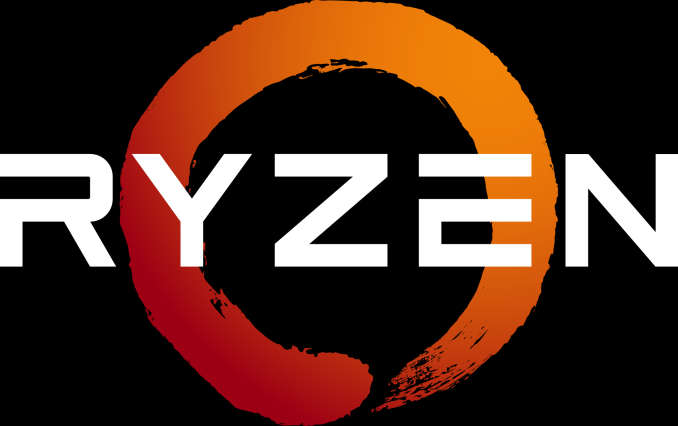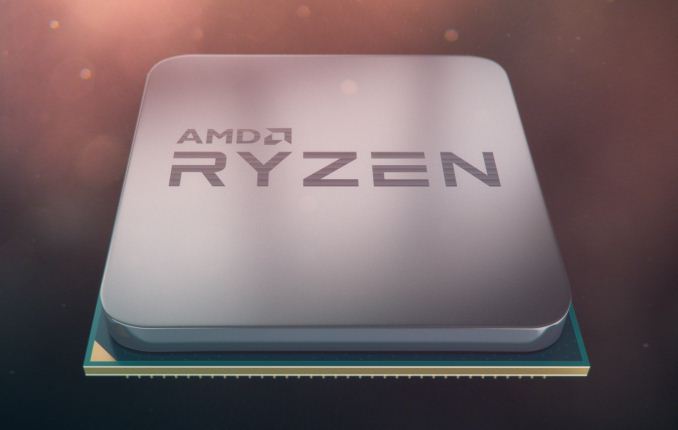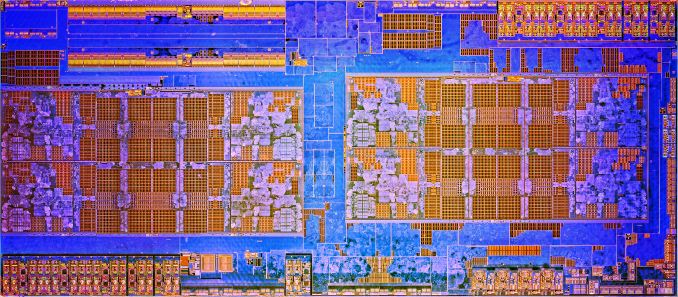AMD Launches Ryzen: 52% More IPC, Eight Cores for Under $330, Pre-order Today, On Sale March 2nd
by Ian Cutress on February 22, 2017 9:00 AM EST
The biggest x86 launch for AMD in five years is today: Ryzen is here. As always before a major launch, AMD gives a ‘Tech Day’ for relevant press and analysts, and through this event AMD’s CEO, Dr. Lisa Su lifted the lid on one of the most anticipated products in the semiconductor industry. AMD knows how to control the level of enthusiasm for its fans, and today is the end result, with processors going on pre-order from major retailers today at 1pm EST, ready for a general hard launch on March 2nd.
In a similar vein to launches of recent smartphones, AMD is doing a staggered announcement/launch with the products on their new microarchitecture. Where Samsung/Apple might give all the details for a product a few weeks before it’s available to buy, today on February 22nd marks the day where AMD is giving consumers information about Ryzen, and specifically the Ryzen 7 family of eight-core products. All the information today is from AMD, and AMD’s internal testing, and pre-orders also start from today for users ready to put down their money for a launch day part. Reviews of the CPUs, as well as when the CPUs will ship to customers, is on March 2nd. This also happens to be right in the middle of two annual shows, Game Developer Conference (GDC) and Mobile World Congress (MWC), making the time between receiving pre-launch samples and being able to provide independent verification of AMD’s performance claims relatively frantic. We’ll do our best!
The Ryzen Family
With a new processor launch, naming the parts and positioning them within the market is critical. So with Ryzen, the processor stack will be split into three based on performance and price: Ryzen 7 at the high end, Ryzen 5 in the middle, and Ryzen 3 for more price-conscious consumers. Both Ryzen 5 and Ryzen 3 are set to be launched later, and Ryzen 7 is the first portion of the family to be released.
Ryzen 7 will have three CPUs to start, all having eight cores and supporting simultaneous multi-threading:
- Ryzen 7 1800X: 8C/16T, 3.6 GHz base, 4.0 GHz turbo, 95W, $499
- Ryzen 7 1700X: 8C/16T, 3.4 GHz base, 3.8 GHz turbo, 95W, $399
- Ryzen 7 1700: 8C/16T, 3.0 GHz base, 3.7 GHz turbo, $329
Ryzen 7 1800X will be the high-end part, featuring a base clock of 3.6 GHz and a turbo of 4.0 GHz, within a TDP of 95W, and for $499. Next to this is Ryzen 7 1700X, launching at $399, with a base/turbo of 3.4/3.8 GHz. The final part for the launch is the Ryzen 7 1700, providing eight cores and sixteen threads for $329 at 3.0/3.7 GHz frequencies.
Processors will initially be available for pre-order from 185 retailers and OEMs worldwide, either as individual parts or pre-built systems.
What, not 40% IPC? 52% IPC??
Enthusiasts and analysts use the term IPC, or ‘Instructions Per Clock’, as a measure of how much the underlying microarchitecture improves from generation to generation. Two decades ago, a good design on a smaller node could net a healthy double-digit gain, whereas in recent years 5-10% gain has become the norm. When AMD initially announced that the new Zen microarchitecture they were developing was aiming for a 40% IPC gain, despite the low IPC they were starting from, users remained skeptical. AMD rehired Jim Keller to work alongside long-term AMD architect Mike Clark and produce a team with several goals in mind: high-performance x86, simultaneous multithreading, and a product to be relevant in the computing, PC, server and mobile space again. So despite this, 40% IPC always seemed a somewhat lofty goal, because Bulldozer was so underwhelming, and despite this low starting point. For the Ryzen launch today, AMD is stating that the final result of that goal is a 52% gain in IPC.
This is something we will need to test in due course!
The Ryzen Silicon, and the Future
AMD pointed out that the new 8-core silicon design runs 4.8 billion transistors and features 200m of wiring. Through previous announcements we’ve examined parts of the microarchitecture including cache sizes, threading, front-end/back-end design, and so on.
AMD Zen Microarchiture Part 2: Extracting Instruction-Level Parallelism
AMD Gives More Zen Details: Ryzen, 3.4 GHz+, NVMe, Neural Net Prediction, & 25 MHz Boost Steps
AMD’s CEO was keen to point out that this is a from-scratch design for AMD, using the knowledge gained from features developed for previous products but ultimately under the hood it looks like ‘a typical x86 high-performance core’, with AMD-specific features and tweaks. We were told that AMD’s roadmap extends into the multi-year range, so while the focus for 2017 will be on this family of products, back at HQ the next two generations are in various stages of development.
BENCHMARKS PLEASE
So despite the 82+ motherboards going to be available, 19 initial PC system builders moving into 200+ through the first half of 2017, the big question on everyone’s lips is how exactly does it perform?
Well, AMD gave us the following numbers:
AMD's benchmarks showed that the top Ryzen 7 1800X, compared to the 8-core Intel Core i7-6900K, both at out-of-the-box frequencies, gives an identical score on the single threaded test and a +9% in the multi-threaded test. AMD put this down to the way their multi-threading works over the Intel design. Also, the fact that the 1800X is half of the price of the i7-6900K.
In a similar vein, again with the Cinebench 15 multi-threaded test, the Ryzen 7 1700X scores over and above the Core i7-6800K (its price competition) and higher than the Core i7-6900K which costs 2.5 times as much.
We’ll tell you what our benchmarks say, with official retail processors. But you will have to wait until March 2nd. Sorry.





















386 Comments
View All Comments
SantaAna12 - Wednesday, February 22, 2017 - link
Right on the $.lucinius - Wednesday, February 22, 2017 - link
true that! 55% of their cpu die is now the integrated graphics processor? yeh tired of subsidising their counter move against ARM ....name99 - Wednesday, February 22, 2017 - link
Is Intel holding back? The problem for the Intel faithful is that Intel has released a stream of uninspiring updates and their handling of the 10nm transition has been a clusterfck from beginning to end. So how to explain that? Unpalatable answers are- Intel is incompetent (sub-variants
+ incompetent at process bringup
+ incompetent at CPU design now that it has become so advanced
+ incompetent at project planning)
- the x86 architecture puts terrible constraints on how aggressively it can be optimized and Intel has pretty much hit those constraints
So what's left to explain the delay in releasing 10nm, the weird (and constantly shifting) Coffee Lake/Ice Lake/server parts first on 10nm story? The palatable answer is that it's all part of a cunning profit-maximizing plot: Intel doesn't need to introduce 10nm yet because they have no competition, so they've been sitting on it, and dribbling out these lame upgrades, until the moment they really are forced to offer something better.
Make of that theory what you will. But if you dismiss it, you then have to give your explanation for the Coffee Lake/Ice Lake/10nm shuffle.
Meteor2 - Wednesday, February 22, 2017 - link
Certainly something is up with Intel, as they have no published or even rumoured plan to compete in the desktop space with AMD. But maybe sales are so small in that area now, they don't care. It's not as if AMD is rolling out 5W x86 processors.lucinius - Wednesday, February 22, 2017 - link
i pretty much agree with what you said, i just wanted to add that the migration to 10nm is a problem for anyone, having done a little physics and some google reminder searches we see that optical light is in the range of approx 300-700nm, and i believe the smallest feature should be half the wavelength of the light etching the surface/? so you can get down to 150nm with standard light, to get shorter u have to go UV direction into 'EUV' ...otherwise they can do a trick i believe by keep re-exposing the same circuit tracks with overlayed frames shifted a few nanometers to keep slicing down the accuracy to the 10nm range....but every extra 'frame' stencil w/e costs loadssss**** and so they really want shorter wavelength light, but to produce that kinda light ...at a good intensity so you don't have to shine it for days just to etch the pattern you want...i believe is a problem all the equipment manufacturers are facing .... and i think this is one of the reasons others have caught up.... plus 'ya know' greed, lethargy all the other sins along with mis-management are to play :) the fact they are at the top of the industry and had to lay off 15k staff points to some serious issues!just some old guy - Thursday, February 23, 2017 - link
Do you have proof that Intel hasn't held back or is this just your opinion? Its like an as_hol_... everyone has one.FourEyedGeek - Sunday, February 26, 2017 - link
You are a sad little twatKrysto - Wednesday, February 22, 2017 - link
If Intel dropped prices by 40% across its products lines, there would be chaos at Intel. I'd be surprised if they even drop them 20% when Ryzen is out, and even then they'll only do it where AMD is actually competing with them. They won't do it for servers for a while, for instance.But even with a 20% price drop, Intel will not be competitive. Intel will have to overhaul its own architecture and make it leaner as well, before it can even compete within a 20% margin difference with AMD. And that won't happen for at least another 3 years.
This is AMD's game to lose now. They have all the advantages, even if they raise their prices after a year or two by 20%. AMD chips should be a no-brainer for everyone. If they don't buy AMD, they probably don't know what they're doing, and they're just going with the "trusted brand, Intel", but not for any technical reasons.
niva - Wednesday, February 22, 2017 - link
You're making an awful lot of assumptions about Ryzen, before you've actually even seen the benchmarks, the energy consumption, etc. This is just PR at this point. While it looks good, and even if it's true, long term stability for workstations running these CPUs has yet to be researched and it will be a few weeks/months to get a more complete picture. Anyone buying machines in the meantime will enjoy discounts on the Intel chips. It's only after sales drop for Intel taht they'll really be pressured into dropping prices.Don't get me wrong, I'm a big AMD fan, matter of fact my livingroom PC still runs an original Phenom, yeah the one with the bug in it... that we only found out after we bought it. I hope the best for AMD, we need the competition badly, but I'll reserve judgment on how good these CPUs really are for the time being.
Vigrith - Wednesday, February 22, 2017 - link
I have to agree.AMD has hyped Vega up really hard, and the numbers that they have released seemed to live up to it, but a lot is still unclear, and will be for the next few months at least.
As much as I would like to exclaim that,'The hammer has fallen. Intel's fate has been decided.', I cannot. Because as of yet, it hasn't. All we know is that Ryzen is way better than Bulldozer, and that it is going to be, at the very least, competitive with the Kabylake chips, and that Intel is going to be under fire pretty soon for their high prices.
But does AMD really has Intel beat? While I definitely hope so, only time will tell. Fingers crossed for March 2nd.
#TeamRed